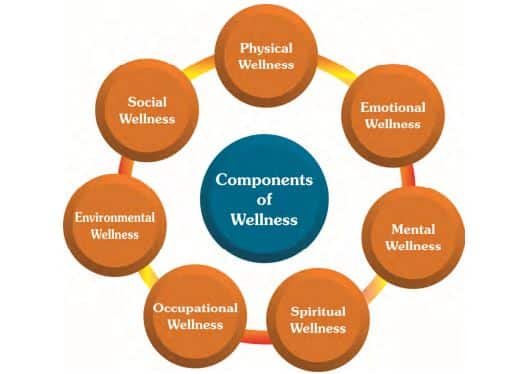Teachers and Examiners (CBSESkillEduction) collaborated to create the Physical Education Class 11 Chapter 5 Notes. All the important Information are taken from the NCERT Textbook Physical Education (048) class 11.
Physical Education Class 11 Chapter 5 Notes
Meaning & importance of Wellness, Health, and Physical Fitness
According to the WHO, “health” refers to a person’s overall physical, mental, and social well-being, not only the absence of disease. Health means feeling good in body, mind and relationships. It is not just about avoiding sickness but also staying strong and happy. Wellness goes beyond health; wellness is about making good choices to live a balanced and fulfilling life.
Important aspects of wellness:
- Physical – Exercise, nutrition, and bodily health.
- Mental & Emotional – Stress management and psychological stability.
- Spiritual – Personal growth and meaningful connections.
- Social – Strong relationships and community involvement.
The seven components of wellness
Wellness is an overall approach to maintaining physical, mental and emotional well-being. There are seven components of wellness, which are interconnected with each other.

- Physical Wellness – It helps to maintain good health through exercise, nutrition and mental balance to handle daily life challenges.
- Emotional Wellness – It helps to manage emotions like self-care, stress reduction and relaxation.
- Mental Wellness – It helps to develop creative thinking, intellectual growth through education, and lifelong learning.
- Social Wellness – It helps to build healthy relationships and helps to interact positively with others.
- Environmental Wellness – Protecting the environment, respecting nature and resources and adopting eco-friendly habits.
- Occupational Wellness – Managing stress and balancing personal life and work. fulfilment in career choice.
- Spiritual Wellness – Personal values, understanding the purpose in life and inner peace.
Traditional Sports & Regional Games for Wellness
Traditional Sports & Regional Games help the individuals to stay active, healthy and connected. This game is helpful for improving fitness, teamwork, and mental focus.
- Physical Health – Games like Kabaddi, Kho-Kho and Gilli Dance make the body strong.
- Mental Well-being – Playing games can reduce stress and keep the mind sharp.
- Social Bonds – Group games help to build friendships and teamwork.
- Cultural Preservation – This game helps to maintain traditions and helps the people to enjoy their roots.
Leadership through Physical Activity and Sports
Leadership means helping and guiding others to reach their goals. Physical education helps the students to work in a team, make decisions and support each other, which is helpful in leadership skills.
How sports build leadership skills:
- Encourages responsibility – Players take charge of team responsibility.
- Develops communication – The player learns to motivate teammates and helps to resolve conflicts.
- Enhance decision-making – In the game, players have to make quick decisions and strategic plans.
- Promotes teamwork – A leader in sports promotes the team and supports the teamwork.
Introduction to First Aid – PRICE method
The PRICE method is basically used in first aid for treating soft tissue injuries like sprains and strains. It stands for:
- P – Protection: Keep the injured area safe.
- R – Rest: Stop moving the injured part.
- I – Ice: Apply ice to reduce pain.
- C – Compression: Wrap the area to prevent swelling.
- E – Elevation: Raise the injured area to reduce blood flow.
Physical Education Class 11 Chapter 5 Notes
Physical Education Class 11 Notes
- Physical Education Class 11 Chapter 1 Notes
- Physical Education Class 11 Chapter 2 Notes
- Physical Education Class 11 Chapter 3 Notes
- Physical Education Class 11 Chapter 4 Notes
- Physical Education Class 11 Chapter 5 Notes
- Physical Education Class 11 Chapter 6 Notes
- Physical Education Class 11 Chapter 7 Notes
- Physical Education Class 11 Chapter 8 Notes
- Physical Education Class 11 Chapter 9 Notes
- Training and Doping in Sports Class 11 Notes
Physical Education Class 11 Questions and Answers
- Physical Education Class 11 Chapter 1 Question Answers
- Physical Education Class 11 Chapter 2 Question Answers
- Physical Education Class 11 Chapter 3 Question Answers
- Physical Education Class 11 Chapter 4 Question Answers
- Physical Education Class 11 Chapter 5 Question Answers
- Physical Education Class 11 Chapter 6 Question Answers
- Physical Education Class 11 Chapter 7 Question Answers
- Physical Education Class 11 Chapter 8 Question Answers
- Physical Education Class 11 Chapter 9 Question Answers
- Training and Doping in Sports Class 11 Questions and Answers
